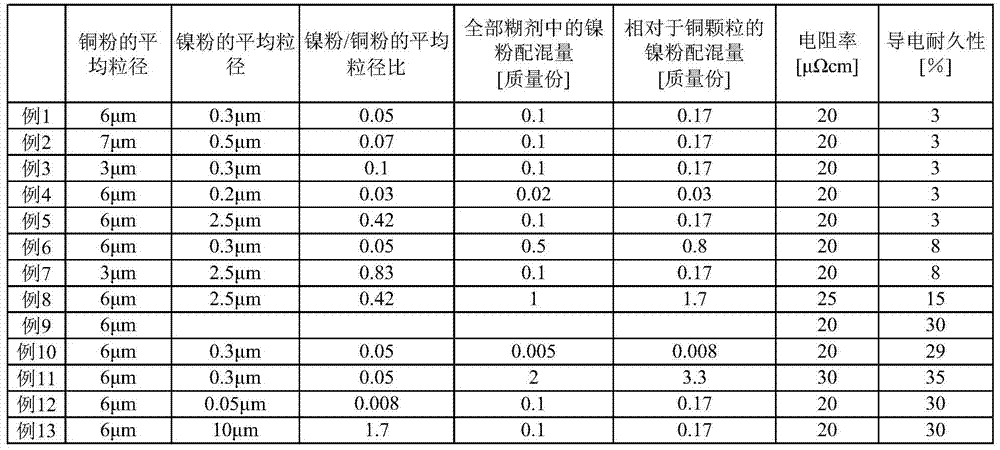Conductive paste and substrate with conductive film
A conductive and paste technology, applied in the field of substrates with conductive films, can solve the problems of damaged conductivity, high cost, deterioration of conductivity, etc., to achieve suppression of deterioration of conductivity, high conductivity, and excellent conductivity Effect
- Summary
- Abstract
- Description
- Claims
- Application Information
AI Technical Summary
Problems solved by technology
Method used
Image
Examples
Embodiment
[0076] Hereinafter, the present invention will be described in further detail through examples, but the present invention is not limited to these examples. Examples 1 to 8 are examples, and examples 9 to 13 are comparative examples. In addition, the average particle diameter of metal particles (copper particles) and base metal particles (nickel particles), the thickness of the conductive film, and the electrical resistivity were measured using the apparatus shown below, respectively.
[0077] (The average particle size)
[0078] Copper particles are used as metal particles. The particle size of the copper particles is calculated as follows: the Feret diameter of 100 particles randomly selected from the SEM image obtained by SEM (manufactured by HITACHI HIGH-TECHNOLOGIES CORPORATION, S-4300) is measured, and the Feret diameter of each copper particle When the maximum radial direction is the long axis and the axis perpendicular to the long axis is the short axis, the average value ...
example 1
[0084] After adding 3.0 g of formic acid and 9.0 g of a 50% by mass aqueous hypophosphorous acid solution to a glass beaker, the beaker was placed in a water bath and kept at 40°C. 5.0 g of copper particles (manufactured by Mitsui Metal Mining Co., Ltd., trade name: 1400YP) having an average particle diameter of 6 μm were slowly added to the beaker, and stirred for 30 minutes to obtain a copper dispersion.
[0085] A centrifugal separator was used to perform centrifugal separation at 3000 rpm for 10 minutes, and the precipitate was recovered from the obtained copper dispersion. The precipitate was dispersed in 30 g of distilled water, and the aggregate was precipitated again by centrifugal separation to separate the precipitate. After that, the obtained precipitate was heated at 80° C. for 60 minutes under a reduced pressure of -35 kPa to volatilize the remaining water and gradually remove it, thereby obtaining copper particles (A) whose particle surfaces were surface-modified.
...
example 2
[0089] The copper particles were obtained in the same manner as in Example 1, except that the copper particles were changed to copper particles (manufactured by NIPPON ATOMIZED METALPOWDERS CORPORATION, trade name: AFS-Cu) with an average particle diameter of 7 μm, and nickel powder was changed to an average particle diameter of 0.5 μm. Copper paste. The value of the average particle diameter of the nickel powder (particles) of the component (B) / the average particle diameter of the copper particles of the component (A) is 0.07.
PUM
| Property | Measurement | Unit |
|---|---|---|
| particle size | aaaaa | aaaaa |
| particle size | aaaaa | aaaaa |
Abstract
Description
Claims
Application Information
 Login to View More
Login to View More - R&D
- Intellectual Property
- Life Sciences
- Materials
- Tech Scout
- Unparalleled Data Quality
- Higher Quality Content
- 60% Fewer Hallucinations
Browse by: Latest US Patents, China's latest patents, Technical Efficacy Thesaurus, Application Domain, Technology Topic, Popular Technical Reports.
© 2025 PatSnap. All rights reserved.Legal|Privacy policy|Modern Slavery Act Transparency Statement|Sitemap|About US| Contact US: help@patsnap.com

